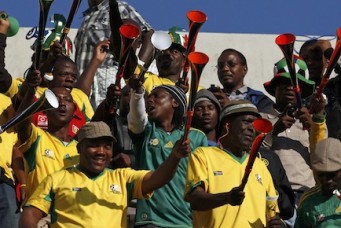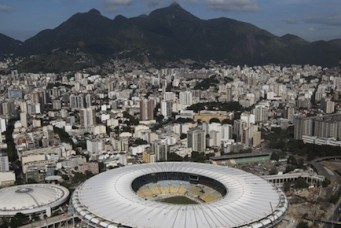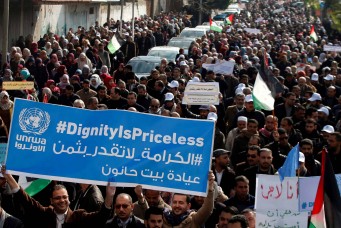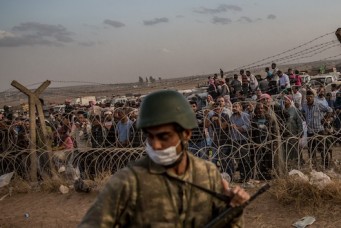The Beautiful Game
Half the population of the planet will tune in to the 2014 World Cup in Brazil. It’s not only a sport we love. It’s the game that explains who we are.
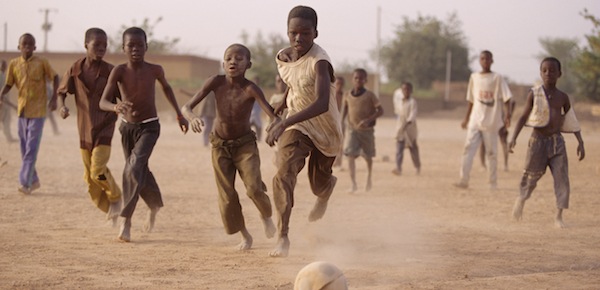
Children playing sandlot football, Burkina Faso, Feb. 1, 1998. Christian Liewig/ TempSport/Corbis
By some measures, nearly half the planet—3.2 billion people in 204 countries—watched the 2010 World Cup in South Africa. Even more will tune in this year when the 2014 World Cup kicks off in São Paulo.
Such staggering numbers prove the cliché that football is the ‘world’s game.’ It is the simplest, most democratic of major team sports, boasting the lowest threshold for entry. No sport is as visible as football, played scrappily in public by people of all backgrounds from the beaches of Brazil to the paddy fields of southwestern India. Unlike cricket or baseball, football is largely uncluttered by rules and requires no special equipment. Unlike basketball or American gridiron, it does not discriminate by body type (Lionel Messi, the best player in the world, stands at a colossal 5’7”). No game moves so fluidly and remains as unbroken by repetitive stoppages and contrived commercial breaks. That seamlessness is the key to the joy of football as a spectacle; the game ebbs and flows, the din of the fans rises in pitch and urgency, the intensity builds and builds until it explodes in the ecstatic release of a goal.
But a better explanation for the power of football lies in its remarkable capacity to take on meaning. Used by anti-colonial rebels and right-wing dictators alike, football has channeled narratives both subversive and authoritarian. Societies can find a mirror for their hopes and anxieties in the collective striving of eleven men in shorts. This is true even in the era of globalization, of which the multi-billion dollar industry of football is an integral part; the sport can both leap across national borders and conjure them.
Identity—and national identity in particular—still drives interest in the sport and remains a powerful force in its quadrennial crowning showpiece, the finals of the Fédération Internationale de Football Association (FIFA) World Cup. What the historian Eric Hobsbawm said of sport in the early twentieth century is true today: competition in the World Cup is an “expression of national conflict, and the sportsmen representing their nation or their state, primarily expressions of their imagined community.”
Football-playing countries often see in their teams a reflection of deeper national character: the organization of the Germans, the artistry and ferocity of the Hungarians, the samba of the Brazilians, the technicality of the Japanese, the muscular flair of the Argentinians, the diversity of the Americans. These descriptions may border perilously on stereotypes, but they are given substance in the form of the team. If the nation is an imagined community, then its football team is that community made flesh.
A Level Playing Field
Football has always been a powerful vehicle for the transmission and cohesion of identity. The origins of the sport remain contested—was it first conceived by the Chinese, the Egyptians, the English?—but from the outset it was a riotous, communal affair. In the British Isles, early forms of the game would hurl an unlimited number of players against each other in a mad, bludgeoning dash to the goal. Whole communities took part in these muddy struggles, scrapping across the fields between their villages, or in the thoroughfares of major towns. It was literally a sport of the masses, played by mobs, pitting hamlet against hamlet, neighborhood against neighborhood. Such was the disturbance caused by these skirmishes that a slew of medieval English and Scottish kings issued proclamations against football. Edward II banned the game in London in 1314, complaining of the “great noise in the city caused by hustling over large balls from which many evils may arise.”
The sport was disorderly and subversive, erupting like a carnival in the midst of the everyday. Even today, many fans are drawn to football for its raucous pageantry. When attending matches at both the club and national level, it is often far more entertaining to watch the antics of supporters massed in the terraces than the game itself. No other professional sport is supported as football is. In many parts of the world, fans organize enormous tifo displays of choreography, with streamers, fireworks, and flags as big as 15,000 square meters. Supporters heave together in the stands, singing coordinated hymns and anthems, their noise often totally oblivious to the proceedings on the pitch. Football fans are not passive consumers of the spectacle; they are its active participants.
This group frenzy is susceptible to darker turns, to the political violence or sporadic thuggery that still tarnish football. That difficult proximity to “hooliganism”—which remains a blight on the game almost everywhere, from South America to Eastern Europe to Egypt—is one of the consequences of football’s unparalleled ability to serve as a vehicle for collective meaning.
When modern football emerged in the United Kingdom in the nineteenth century, it sprung from communal roots. The first football clubs were formed around associations of workers and church groups. Unlike the franchises of contemporary American sports or Indian cricket’s Premier League, football clubs grew organically from communities. They were social institutions, often representing towns, ethnic groups, and vocations. The London-based football club Arsenal, for instance, may now boast a vast global brand, but it began modestly as the sporting club of the munitions workers of the Royal Arsenal, men who simply sought distraction from their industrial endeavors in those of the rolling ball.
The sport spread in large part on the coattails of the globe-trotting, imperial British. They brought it famously to its hotbeds in Argentina, Uruguay, and Brazil. The legacy of that introduction lives on in the names of storied South American clubs: Corinthians, Boca Juniors, Newell’s Old Boys, River Plate, Montevideo Wanderers. Football also blossomed in less familiar stretches of the global football map. Colonial agents in India (particularly in Bengal) encouraged its play. In Iran, football was taught to the European-educated children of the elite, while British operatives in the oil industry spread the game among the workers on the oil fields of Khuzestan. British telegraph workers made it popular in East Africa. Belgian missionaries in the Congo promoted the sport as a civilizing force, part of the muscular Christianity they wanted to inculcate in the natives.
Not surprisingly, football became a medium of anti-colonial resistance. Sport leveled the playing field, introducing a parity between colonized and colonizer that did not exist elsewhere in colonial society. The Cairo club Al Ahly—whose fans have played stirring and tragic roles in Egypt’s recent upheavals—was founded in 1907 by patriotic, anti-colonial students. In 1911, the Kolkata-based club Mohun Bagan ignited the imagination of a nascent country when it beat an English team in the final of British India’s top football tournament. According to the Indian scholar Kausik Bandyopadhyay, “football began to be identified with something very akin to fighting the colonial masters.” Not only did the Indian side win against the odds, they beat the British while playing barefoot.
When many societies groaned under the burden of Western domination, football helped restore a measure of dignity to subjugated peoples. Stirring tales of defeating the European at his own game cropped up around the world in the early twentieth century. In late 1925, a football club in Zanzibar called Caddies (formed by the employees of colonial golf courses) won an island-wide tournament after brushing aside a British team. Caddies’ players triumphed over the men whose bags they carried on the golf course; here football flattened the very real social hierarchy accentuated by golf. A year later in Tehran, Iran’s monarch Reza Shah was in the audience to watch a team of Iranians vanquish a side composed of European expats. The Shah threatened to leave after his countrymen conceded a goal, but was mollified when the Iranians replied with two of their own.
On the grand international stage, football offers great possibilities for perennial underdogs. In the Olympics, behemoth countries like the United States and China inevitably rack up the most medals. By contrast, anything can happen in the World Cup.
That hope can lead to poignant drama and bitter tragedy. During their match in the 1994 World Cup, it seemed tantalizingly possible that little, impoverished Bolivia might upset Germany, a football superpower. A Bolivian victory would not only have marked a sporting triumph, but an inversion of global hierarchies, of the European over the indigenous South American, of a fraught history of power and exploitation. It was not to be. Bolivia’s star player Marco Etcheverry was thrown out of the game for a tempestuous foul. His country slumped to defeat. The Uruguayan writer Eduardo Galeano described the debacle best: “Bolivia collapsed, wishing they had never sinned against the secret spell cast from the depths of centuries that obliges them to lose.”
Nation Versus Nation
Combative, nationalist politics surface frequently in the sport. With good reason, football is often described as a metaphor for war, the sublimation of politics into the contests of men scampering after a ball. Take, for instance, the battles of identity within the United Kingdom. Football in the UK is often freighted with the tension of its strained political union. Unlike the International Olympic Committee, FIFA—football’s gargantuan governing body—recognizes England, Scotland, Wales, and Northern Ireland as separate sporting entities. So nationalists in the Celtic fringe of the United Kingdom were in high dudgeon when Great Britain fielded a joint team in the 2012 London Olympic Games. Such a unified team threatened their sense of separation from overbearing England.
That pride in internal difference, however parochial, has long animated clashes between England and the other so-called “home nations.” Until the 1980s, Scottish fans would descend onto London every other year to attend matches against England. They would jam Trafalgar Square, waving Scottish flags and brandishing banners that evoked the memory of Bannockburn, the famous medieval battle in which the Scots repelled the invading English. British authorities grew so wary of the biannual Scottish “invasion” that they suspended the regular series of matches between the two teams. Now, as Scotland inches towards full independence, its football rivalry with England stands to only grow in intensity and significance.
The World Cup itself has witnessed the drama of hostile nations grappling with each other. Not only did the great Argentinian team of 1986 (led by the irresistible, dogged genius Maradona) win the tournament, but along the way they exacted revenge for the humiliation of the Falklands War, beating England in what remains one of the most memorable matches in World Cup history. In 1998, Iran took on the United States in a game loaded with all the animosity that defined U.S.-Iran relations since the toppling of the pro-American Shah in 1979. Iran triumphed, sending its people into delirious celebration and the United States trudging dejectedly out of the tournament.
Unlike in the Olympics, in which wealthy superpowers dominate, there is no direct relationship between the prosperity and status of a country and the success of its representatives on the football field. That is why the sport can galvanize such passion and common feeling even in the tiniest of nations.
Small countries often coalesce around football. Alongside the other trappings of statehood—passports, a postal system, a currency, and so on—a football team is just as essential a pillar of national identity. When South Sudan came into existence as an independent country in July 2011, it immediately staged a football match between its cobbled-together side and a Kenyan football club. “We are ready to tell the world that South Sudan is around,” the striker Khamis Leiluno proclaimed before the match. South Sudan lost, but the result was incidental to the fact of the game and its confirmation of the independence of South Sudan.
Football also serves nations that do not exist yet. At the onset of Franco’s dictatorship in Spain, a football team composed of the best players from the Basque Country toured Europe and then Latin America in 1937, raising awareness of the plight of the Basques. Today, Basque nationalists stage unofficial matches pitting their team, the Euskal Selekzioa, against other aspiring nations (like Catalonia) and full-fledged countries (the Basques thumped Peru 6-0 this past December).
FIFA may have more members (209) than the United Nations (193), but alternative tournaments outside of FIFA’s jurisdiction exist for peoples who have not yet found a place in the traditional community of nations. In these competitions, the likes of Northern Cyprus, Greenland, Chechnya, Zanzibar, Darfur, Occitania (southern France), Sápmi (representing the Sami people of Scandinavia), and Arameans Suryoye (a team for the global Aramean-Syriac diaspora) battle in earnest. Of course, what they do on the football pitch will never win them statehood. But through football, their claims to a unique identity gain, however fleetingly, a substance and meaning that geopolitics denies them.
Qatar in 2022
Just as football empowers the stateless, so too can it serve the iron interests of states. Edward II may have sought to ban football, but the modern game’s capacity to capture the popular imagination has made it a favorite of strongman rulers.
When Italy hosted the World Cup in 1934, Benito Mussolini turned the tournament into an exercise in propaganda, boasting of the virtues of fascist rule and the superiority of the Italian race. It helped Mussolini’s cause immensely that Italy emerged victors of the tournament (thanks in part to the dark arts of match-fixing). Two years after a military coup, Argentina hosted the 1978 World Cup. Like the Italians in 1934, Argentina was the eventual champion (also benefiting from insidious match-fixing). The tournament gave the ruling junta the opportunity to present a burnished image of the country to the world and to Argentinians. The glittering World Cup strengthened both regimes and distracted attention from their abuses.
Since it was first televised in 1966, the World Cup has become football’s crowning showpiece, a month-long exhibition of sporting brilliance and super-charged commercial muscle. For its hosts, the tournament is a public relations coup, a chance to project an image of the nation to the world. For FIFA, the tournament is the ultimate money-spinner. The 2010 World Cup earned FIFA upwards of $2 billion in profit, almost entirely on the back of the sale of TV and marketing rights. That astronomic sum is a measure of both football’s popularity and the extent to which money controls the direction of the game.
FIFA’s award of World Cups to countries has become an increasingly controversial and politicized subject. Activists in both South Africa and Brazil protested the arrival of the grand football jamboree, treating the World Cup as a glaring and unaffordable excess in societies riven by inequality and deprivation. Critics fear that governments will bask in the global good feeling that comes with the World Cup, spinning sport into a glittering spectacle while suppressing real problems and failures.
Competition for the right to host the World Cup is fierce and often vindictive. Some of the bile that arose in the West with the award of upcoming tournaments to Russia (2018) and Qatar (2022) can be attributed to resentment and jealousy (England and the United States both failed in their bids). But with the World Cup set to be played in two countries with limited political freedoms and dubious human rights records, it seems that FIFA’s quadrennial pageant will continue to serve the ends of authoritarian regimes.
The World Cup can also do a measure of good. The 2006 tournament held in Germany had the effect of inspiring an emboldened, warm love of country among the hosts. For decades, Germans had been understandably wary of displays of national pride, mindful of their role in the barbarity of World War II. Yet Germans thronged the squares of their country during that June, chanting and waving flags, embracing their youthful team in its quest for glory. These displays suggested to many that Germany had reconciled with and overcome the burden of its past. As one German told the Guardian newspaper, “I never put up a flag before because it felt strange. Now I have had one in my window for three weeks. It is going to feel too empty if I take it down, so I decided I am going to keep it up for good.”
Search for Identity
As much as the energies and passions produced by football engender hate and antagonism, so too does the sport force a mingling of differences. Iraq’s national team brings together the otherwise fractious Kurds, Sunni, and Shia sections of the country. The South Sudanese team unites players from various ethnic groups. Football can conjure a unity that reality otherwise makes elusive.
When France triumphed in the 1998 World Cup, its team embodied an unabashedly multicultural image of the country. African, Caribbean, and white players worked seamlessly together, all inspired by the cavalier talent of Zinedine Zidane, the son of Algerian immigrants. Other European teams reflect the growing diversity of their populations: England, for instance, has long selected players of African and Afro-Caribbean descent; the parents of Sweden’s best player, Zlatan Ibrahimović, are from Bosnia and Croatia.
At the same time, countries that lose immigrants abroad are turning to their diaspora to bolster their teams. Many West African teams pack their ranks with players from the exurban banlieues of France, men who have chosen to play for their countries of ancestry rather than the country of their upbringing. Similarly, Turkey has long called upon players raised and educated entirely in Germany, descendants of the “guest-workers” who migrated from Anatolia decades ago. Many of the stars of the Jamaican and Trinidadian national teams grew up on the streets of London, not along the beaches of the Caribbean. And in the 2014 World Cup in Brazil, two brothers from Berlin will face off against each other when Jérôme Boateng plays for Germany and Kevin-Prince Boateng for Ghana.
This scattered cartography of belonging may seem like some quirk of the shrinking twenty-first century world, but in the history of football it is nothing particularly new. Long before “globalization” entered our vocabulary, South Americans of Italian ancestry were playing for Italy, Hungarians represented Spain, and Eusébio, a young man from Mozambique, became the greatest Portuguese player of all time.
In the modern era of fast travel and faster information, football reaffirms the truth that identity is so often a choice, one made potentially out of convenience, but also out of genuine feeling. Afghanistan upset regional power India in September 2013 to win bragging rights in South Asia for the first time. Among the war-torn nation’s triumphant squad was twenty-six-year-old Yousef Mashriqi, a man born and raised in the Flushing neighborhood of New York City, who played his professional football in India. Victory meant as much to this itinerant, globe-trotting footballer as it did to his colleagues who grew up and lived in Afghanistan. “I would like to congratulate our country for winning the title,” he said. “Hopefully, it will bring unity there, if only a small percentage more. Soccer spreads love and peace.”
Kanishk Tharoor is a New York-based writer who has contributed to the Guardian, Independent, New Yorker, Foreign Policy, National, Sports Illustrated, and Times of India, among other publications. He previously served as associate editor of openDemocracy, an online magazine. On Twitter: @kanishktharoor.

